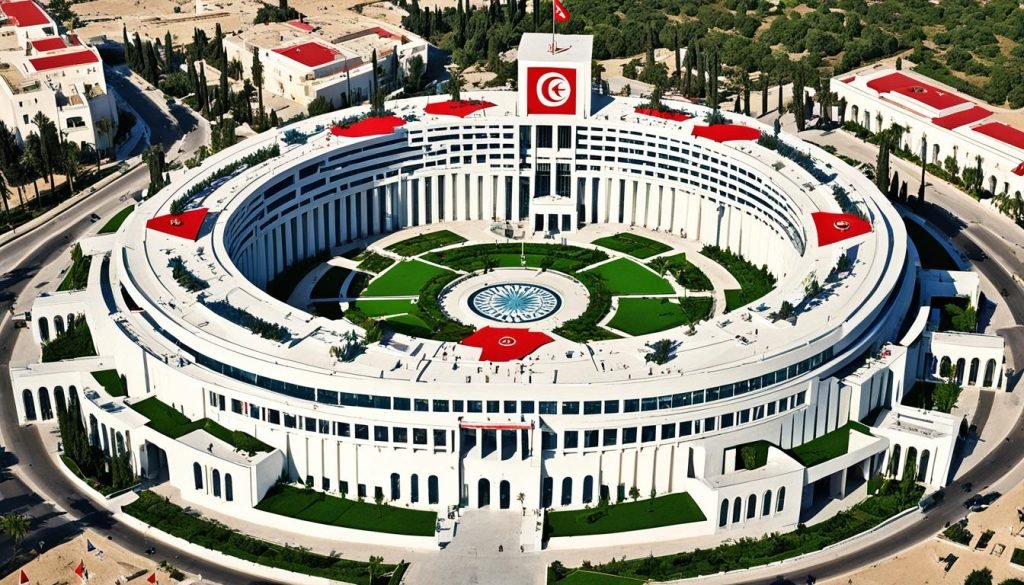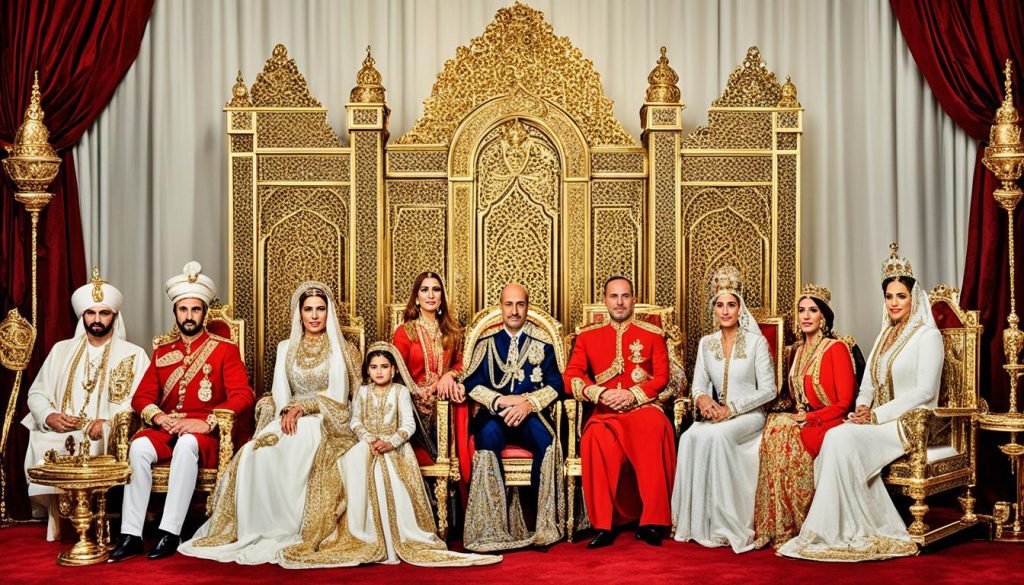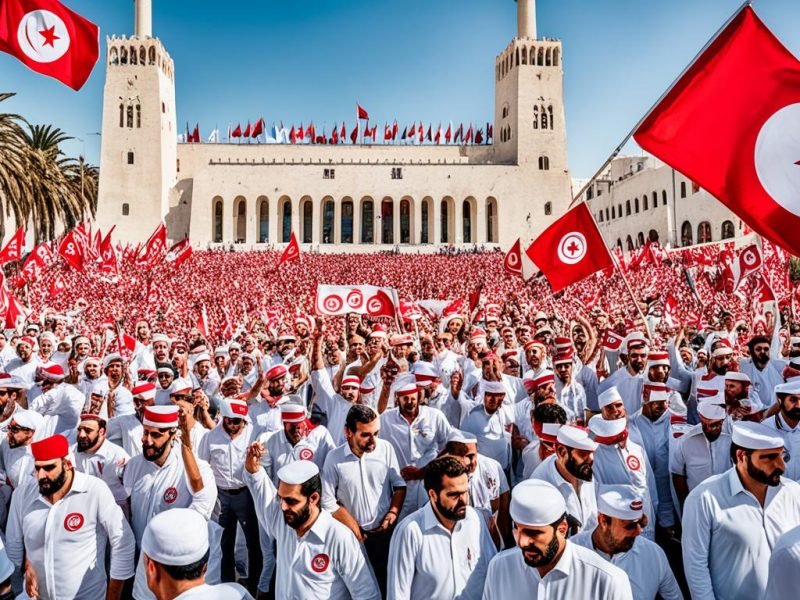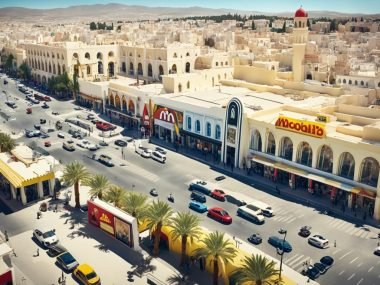On my journey into Tunisia’s past, I looked at its political system. I found stories of Tunisia’s monarchy that most don’t talk about. When Tunisia became free from France on March 20, 1956, it became the Kingdom of Tunisia.
But the kingdom didn’t last long, ending after just one year and five months. On July 25, 1957, Tunisia became a republic. During its short time as a kingdom, Tunisia picked new symbols and made a constitution. This constitution was for a monarchy and had Muhammad VIII al-Amin as the king.
Key Takeaways
- Tunisia’s political structure changed from a monarchy to a republic.
- The Kingdom of Tunisia started after gaining independence and was short-lived from 1956 to 1957.
- Muhammad VIII al-Amin was the only king in Tunisia’s history.
- New national symbols and a constitution were major steps in Tunisia’s time as a monarchy.
- The change to a republic was a big moment for Tunisia and North Africa.
The Brief Reign of Tunisia’s Monarchy
After gaining freedom from France, Tunisia started a new chapter. It was the birth of the Kingdom of Tunisia. This event changed the country’s government structure in Tunisia and Tunisian dynasties.
Establishment of the Kingdom of Tunisia in 1956
In 1956, Tunisia changed from being under French control to its own kingdom. This change greatly transformed Tunisia’s political and social life. Muhammad VIII al-Amin became a king, symbolizing unity and starting a new government structure in Tunisia.
King Muhammad VIII al-Amin’s Role and Ascension
Before becoming king, Muhammad VIII was the last Bey of Tunis. His becoming king continued the Tunisian dynasties. Yet, he mostly had a ceremonial role, with the Prime Minister holding the real power.
The End of the Monarchy and Proclamation of the Republic
The monarchy didn’t last long, ending in 1957 with a new republic led by Habib Bourguiba. This move ended royal rule and began major social changes. It was a key change in the history of Tunisian kings, leading to a modern republic.
Tunisia’s Political Evolution Post-Independence
In 1957, Tunisia changed from a monarchy to a republic. This big change helped redefine its political setup. The legacy of the Tunisian monarchy is still felt today. But now, it’s in the context of modern governance.
Shift to Republic Under President Habib Bourguiba
The change from monarchy to republic was huge. It changed how Tunisia was governed. President Habib Bourguiba led the shift. He worked to make Tunisia different politically and socially. I saw how society dealt with these changes.
Modern Government Structure in Tunisia
As a journalist, I’ve seen Tunisia’s parliamentary democracy up close. This system keeps the royal family as a historical note. It shows the shift from old royal rule to new republican ideals. The President and Prime Minister share power in this setup.
This mix of old and new is fascinating. It marks a big change from the past monarchy. It’s important for understanding Tunisia’s political changes.
| Political Structure | Role under Monarchy | Role under Republic |
|---|---|---|
| Head of State | King – Symbolic and ceremonial duties | President – Executive powers |
| Government Leadership | Controlled by royal decree | Led by elected Prime Minister |
| Political Reforms | Minimal – Power centralized | Extensive – Emphasis on democracy and public welfare |
Tunisia’s shift to a parliamentary democracy shows a big change. It’s a move towards democracy and away from monarchy. This highlights Tunisia’s progress in political systems.

Understanding the Government Structure in Tunisia
Tunisia has a strong political system that listens to its people. It also keeps the government stable. In the past, the Tunisian ruling family was very influential. Now, the focus is on democracy and strong institutions.
Constitutional Framework and Executive Powers
The constitution is key to Tunisia’s government, keeping the powers in check. The President, chosen by the people, unites the country and follows the constitution. They handle national defense and work with foreign countries.
The Prime Minister, working with the President, manages domestic matters.
Parliamentary Democracy and the Role of the Assembly
Tunisia values democracy, seen in its parliamentary system. The Assembly plays a big role in making laws. It represents the people and has a big say in the country’s policies.
The influence of the Tunisian ruling family in politics is less now. This change makes the system more democratic.
| Government Branch | Role | Key Powers |
|---|---|---|
| Executive (President) | Chief of State | Foreign Policy, National Defense |
| Legislative (Assembly) | Lawmaking | Enactment of Legislation, Budget Approval |
| Judicial | Interpretation of Laws | Judicial Review, Legal Adjudication |
An Insight into the Royal Family of Tunisia
Looking into the history of Tunisian kings uncovers a story of beauty, power, and big changes. The Royal family of Tunisia started in the early 18th century. They ruled for centuries until the mid-20th century. To really understand their mark, I study their family tree and their big effect on the Tunisian monarchy.

King Muhammad VIII al-Amin’s rise to power is a key story in the history of Tunisian kings. His time as king was short but meaningful. He saw the country change from a kingdom to a republic. This was a very important and changing time. It massively changed Tunisia’s society and politics.
I recall learning about King Lamine Bey’s fall. This led to losing royal lands and treasures. This was a symbol of an ending time. The royal family’s life changed a lot. They went from leaders to common people. This story shows the major changes in Tunisia’s history.
Today, the story of the Royal family of Tunisia lives on in history. It shows their important role and big impact on making modern Tunisia. The remains of the Tunisian monarchy remind us of a royal past. They also show how the country moved forward towards being a republic.
Legacy of the Tunisian Monarchy in North Africa
The Tunisian dynasties left a lasting mark on Tunisia’s culture and society. Even though the monarchy ended decades ago, its effects are still seen today.
Influence of Monarchy on Tunisian Culture and Society
The monarchy’s impact is clear in Tunisia’s arts, architecture, and social norms. Traditional ceremonies and the design of old buildings show the ruling family’s influence. This mix of the past and present shapes Tunisia’s identity today.
Comparative Monarchies in the Region
Tunisia’s monarchy was shorter than others in North Africa but very impactful. It shifted quickly to a republic. This change made Tunisia different from its neighbors.
This shift offers a unique perspective compared to other North African countries. Tunisia’s brief royal era laid the groundwork for major changes. These differences highlight Tunisia’s distinct cultural path.
Conclusion
In my journey to learn about Tunisia, I found its history very interesting. Tunisia has changed a lot over time. It used to have kings but not anymore. Now, it is a republic where people’s votes matter more than kings. This shows how much Tunisia has evolved.
The story of its kings is still important to Tunisia. When it became a kingdom, it changed Tunisia forever. Even without a king now, the country respects its past. But, it looks towards a future of progress and self-rule.
Tunisia today is vibrant and full of life. Its history of kings has led to a strong democracy. This story shows that countries can change for the better. The spirit of Tunisia is all about moving forward and making its own choices.







